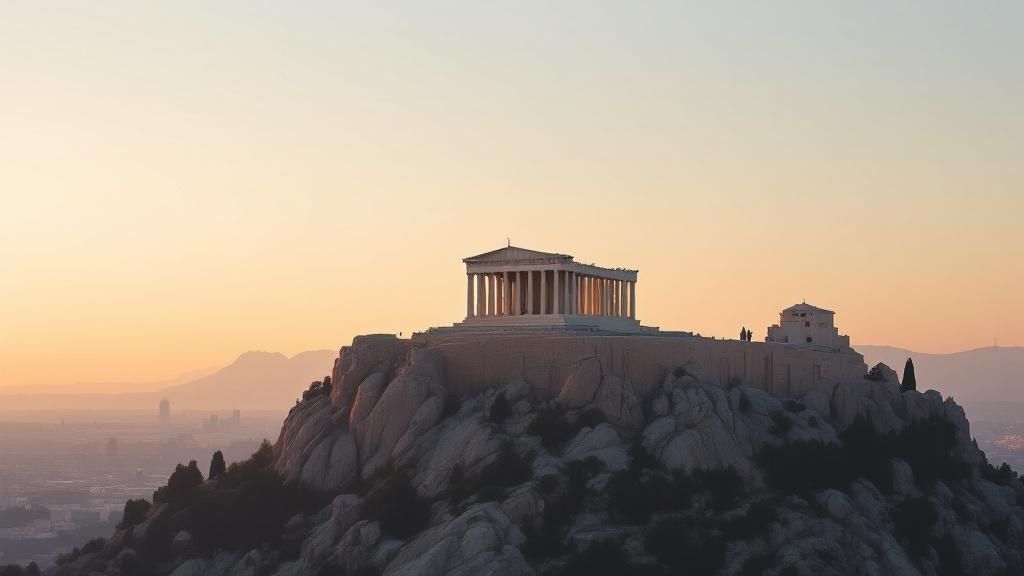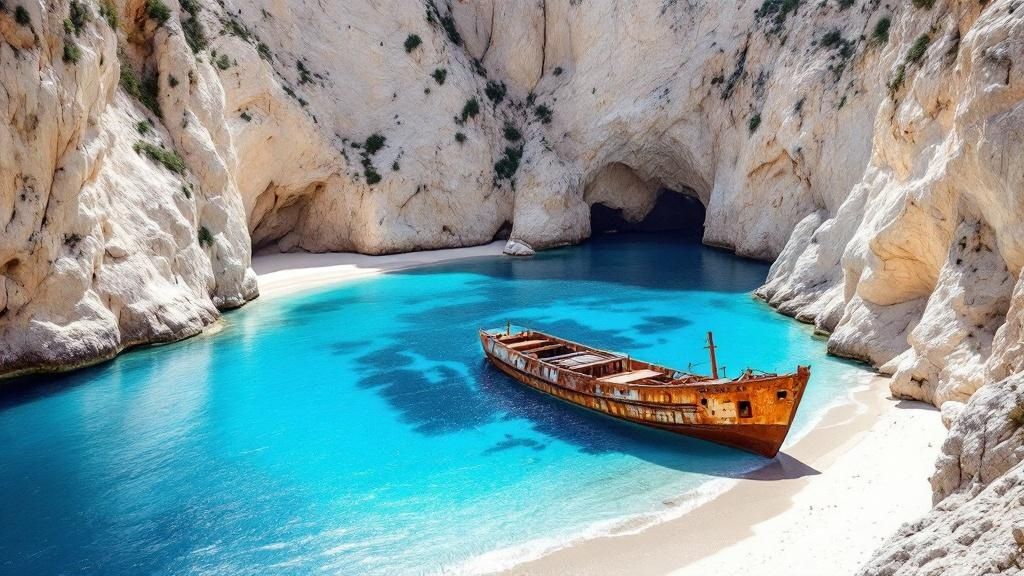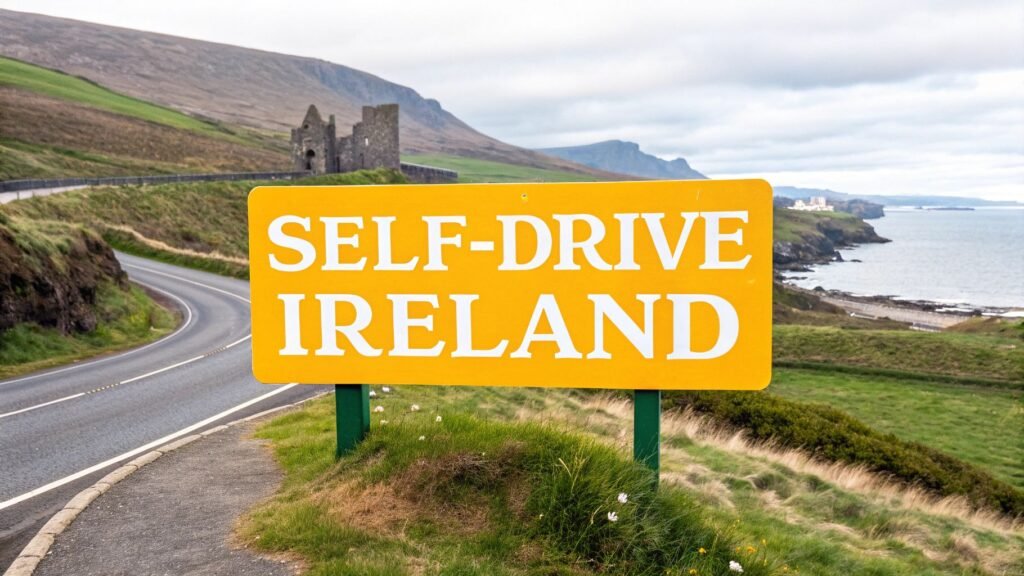Greece offers a journey through millennia of history, sun-drenched islands, and landscapes that have inspired myths for centuries. Choosing where to go can feel like an epic quest in itself. This guide moves beyond the typical postcard snapshots to provide a curated list of ten essential places in Greece, each offering a unique window into the country's soul. We aim to equip independent travellers, families, and cultural explorers with the practical insights needed to navigate these iconic locations with confidence.
From the hallowed ruins of Athens to the surreal beauty of Meteora, we will explore the must-see features of each destination, balancing the highlights with realistic advice. You will find actionable tips on what to see, how to get there, and how to best organise your time, ensuring your adventure is as seamless as it is spectacular. Whether you're planning a detailed self-drive tour or seeking inspiration for your next Aegean escape, this curated list provides the foundation for an unforgettable Hellenic experience. For those looking to extend their explorations beyond Greece, a comprehensive Europe travel guide can help map out further adventures across the continent.
1. Acropolis of Athens
The Acropolis of Athens stands as a potent symbol of Western civilisation and one of the most essential places in Greece to visit for any cultural explorer. Perched atop a rocky hill, this ancient citadel, commissioned by the statesman Pericles in the 5th century BC, represents the zenith of Classical Greek artistic and architectural achievement. Its crowning glory, the Parthenon, was meticulously designed by Ictinus and Callicrates, with sculptural decorations overseen by Phidias, creating an enduring legacy that has inspired structures like the US Supreme Court.

This site is more than just ruins; it's a direct connection to the birthplace of democracy, philosophy, and theatre. For families and history enthusiasts, exploring the Acropolis offers a tangible lesson in ancient history, bringing textbooks to life amidst the iconic columns of the Parthenon and the elegant Caryatids of the Erechtheion.
Actionable Tips for Visiting the Acropolis
To make the most of your visit to this monumental site, strategic planning is key. The intense Greek sun and large crowds can pose challenges, but these can be easily managed.
- Book Online: Purchase your tickets in advance from the official Hellenic Heritage website. This allows you to bypass the often lengthy ticket queues, saving valuable time. Consider the combined ticket if you plan to visit other archaeological sites like the Ancient Agora.
- Time Your Visit: Arrive just as it opens at 8 AM or in the late afternoon, about two hours before closing. This helps you avoid both the peak tourist crowds and the sweltering midday heat.
- Essential Gear: Wear comfortable, sturdy shoes with good grip, as the ancient marble paths can be uneven and slippery. Sunscreen, a hat, and a reusable water bottle are non-negotiable, as shade is extremely limited on the citadel.
- Context First: For a richer experience, visit the Acropolis Museum before you ascend the hill. Seeing the original artefacts and detailed exhibits will provide crucial context and deepen your appreciation for the structures you are about to see.
2. Santorini (Thira)
Santorini is the supermodel of the Greek islands, a world-famous destination celebrated for its dramatic cliffs and whitewashed villages clinging to the caldera's edge. This crescent-shaped jewel in the Cyclades was formed by a cataclysmic volcanic eruption around 1600 BC, creating one of the most visually stunning landscapes on Earth. Its iconic blue-domed churches and radiant sunsets, particularly in Oia, have made it one of the most sought-after places in Greece for romantics, photographers, and luxury travellers.

Beyond the postcard-perfect views, Santorini offers a rich tapestry of experiences, from exploring the remarkably preserved Minoan settlement of Akrotiri to wine tasting at volcanic vineyards. The island’s unique geology gives rise to distinctive red and black sand beaches, providing a stark contrast to the brilliant white villages. A Cyclades island hopping adventure often centres around Santorini's undeniable allure.
Actionable Tips for Visiting Santorini
To fully appreciate Santorini's magic while navigating its popularity, a little planning goes a long way. These tips will help you discover its authentic charm beyond the main crowds.
- Visit in the Shoulder Season: Plan your trip for April-May or September-October. You'll enjoy pleasant weather, fewer tourists, and more reasonable prices compared to the peak summer months.
- Book Accommodation Early: Rooms with caldera views are in high demand and get booked up months, or even a year, in advance. Secure your lodging as early as possible to get the best choice.
- Explore Beyond Oia: While Oia's sunset is famous, it's also incredibly crowded. For a more peaceful experience, watch the sun go down from the Akrotiri Lighthouse, the village of Pyrgos, or Imerovigli.
- Rent an ATV or Car: To truly explore the island's hidden gems, from secluded beaches to traditional villages, renting your own transport provides the ultimate freedom and flexibility.
- Savour Local Flavours: Don't miss the island’s unique culinary specialities. Seek out restaurants serving tomatokeftedes (tomato fritters), Santorini fava, and dishes featuring the local white aubergine.
3. Delphi Archaeological Site
Once considered the very centre or 'navel' of the ancient world, the Delphi Archaeological Site is one of the most spiritually resonant and visually stunning places in Greece. Nestled on the slopes of Mount Parnassus, this was the home of the legendary Oracle of Apollo, a high priestess whose cryptic prophecies guided kings and commoners alike. The sanctuary, a major cultural hub from the 8th century BC, hosted the Pythian Games, second only in importance to the Olympics.

Exploring this expansive site allows history enthusiasts and cultural travellers to walk through the ruins of the Temple of Apollo, the ancient theatre, and the stadium. The dramatic mountain backdrop adds a powerful sense of atmosphere, making it easy to imagine the weight of the decisions made here, from Croesus of Lydia's fateful query about war with Persia to the philosophical inquiries inspired by Delphic maxims like 'Know Thyself'.
Actionable Tips for Visiting Delphi
To fully appreciate the magic and history of Delphi, a little planning goes a long way. The site is large and located on a steep incline, so preparation is key.
- Arrive Early or Stay Local: To beat the tour buses and the midday sun, aim to arrive right at the 8 AM opening. Staying overnight in the modern town of Delphi or the charming nearby mountain village of Arachova makes this much easier.
- Sturdy Footwear is Essential: The ancient pathways are steep, uneven, and can be slippery. Comfortable walking shoes or hiking boots with good grip are crucial for navigating the site safely and enjoyably.
- Allocate Ample Time: Give yourself at least 3-4 hours to explore the main archaeological site and the adjacent museum, which houses masterpieces like the Charioteer of Delphi. The two are covered by a single ticket.
- Don't Miss the Tholos: A short walk (about half a mile) down the main road from the primary site leads to the Sanctuary of Athena Pronaia, home to the iconic and highly photogenic Tholos, a circular temple of immense beauty.
4. Meteora Monasteries
The Meteora Monasteries offer one of the most surreal and spiritually profound landscapes in Greece, making it an unmissable destination for cultural explorers and nature lovers alike. This extraordinary complex of Eastern Orthodox monasteries is built atop immense natural rock pillars that rise dramatically from the Thessalian plain. Founded by monks seeking isolation between the 14th and 16th centuries, these ‘suspended in the air’ sanctuaries represent a monumental feat of faith and engineering.

Today, six of the original 24 monasteries remain active and welcome visitors, creating a UNESCO World Heritage site that feels otherworldly. The site’s unique geography even caught Hollywood's eye, with the Holy Trinity Monastery famously featuring in the 1981 James Bond film For Your Eyes Only. Exploring these monasteries offers a glimpse into a life of solitude and devotion, surrounded by breathtaking panoramas.
Actionable Tips for Visiting Meteora
To fully appreciate the magic of Meteora, careful planning is essential. The logistics of visiting multiple monasteries require a thoughtful approach to timing and attire.
- Check Schedules: Each monastery operates on a different schedule and closes on a specific day of the week. Check the official opening times online before your visit to avoid disappointment.
- Dress Respectfully: This is an active religious site. Shoulders must be covered, and men must wear long trousers while women should wear long skirts. Wraps and skirts are usually available at the entrances, often for a small fee.
- Time Your Visit: Arrive early in the morning or late in the afternoon to experience the best light for photography and to avoid the large tour bus crowds that descend midday. Staying overnight in nearby Kalambaka or Kastraki allows you to witness a spectacular sunset.
- Flexible Transport: Renting a car or scooter provides the most flexibility for travelling between the monasteries. For an immersive experience, consider hiking the ancient trails that connect some of the sites, offering unique perspectives you can’t get from the road. A self-drive tour can be an excellent way to explore Meteora and other classic Greek sites at your own pace.
5. Crete (Knossos Palace & Island)
Crete, the largest of the Greek islands, is a destination so diverse it could be a country in its own right. It is one of the most essential places in Greece for those seeking a blend of ancient history, dramatic landscapes, and vibrant local culture. The island was the cradle of the Minoan civilisation, Europe's first advanced society, whose legacy is spectacularly preserved at the Palace of Knossos. This sprawling archaeological site, famously excavated by Sir Arthur Evans, brought the myth of the Minotaur and his labyrinth to life.
Beyond its Minoan roots, Crete offers a staggering variety of experiences. From the pink sands of Elafonisi beach and the epic Samaria Gorge to the charming Venetian harbour of Chania, the island captivates every type of traveller. Its unique identity, shaped by figures like author Nikos Kazantzakis (Zorba the Greek), is also evident in its world-renowned cuisine, a cornerstone of the healthy Mediterranean diet.
Actionable Tips for Visiting Crete
To truly appreciate Crete's scale and diversity, a well-planned approach is necessary. The island's size means you cannot see it all from one base.
- Regional Bases: Allocate at least 5-7 days and base yourself in different regions to minimise travel time. Stay in Chania for the west, Heraklion or Rethymno for the centre, and Agios Nikolaos or Elounda for the east.
- Rent a Car: To explore beyond the main tourist hubs and discover authentic mountain villages and secluded beaches, renting a car is almost essential. Public transport between regions can be infrequent.
- Knossos Strategy: Visit the Palace of Knossos first thing in the morning (at 8 AM) to avoid the large tour groups and the intense midday heat. Consider hiring a licensed guide at the entrance for a richer understanding of the complex site.
- Embrace the Cuisine: Venture beyond tourist restaurants. Seek out local tavernas to try authentic Cretan specialities like dakos salad, slow-cooked antikristo lamb, and local graviera cheese. Taking a local cooking class is a fantastic way to engage with the culture.
6. Mykonos
Mykonos is a glamorous jewel in the Cyclades, celebrated globally for its vibrant nightlife, cosmopolitan atmosphere, and iconic whitewashed architecture. This 'Island of the Winds' has masterfully evolved from a humble fishing community into one of the Mediterranean's most sophisticated and sought-after destinations, drawing a jet-set crowd since Jackie Kennedy Onassis first visited in the 1960s. Its allure is a blend of high-energy beach clubs like Scorpios, which set global trends, and serene, traditional charm.
Beyond the legendary party scene, Mykonos offers a richer experience. Independent travellers and families can explore the labyrinthine streets of Mykonos Town, discover secluded beaches, or visit authentic villages like Ano Mera. Its proximity to the sacred island of Delos, one of Greece's most significant archaeological sites, makes Mykonos an unmissable stop among the many incredible places in Greece.
Actionable Tips for Visiting Mykonos
To fully enjoy Mykonos while navigating its popularity and prices, a bit of forward planning goes a long way.
- Book Well in Advance: Accommodation, popular restaurants, and even sunbeds at famous beach clubs should be reserved months ahead, especially for travel between July and August.
- Optimal Timing: Visit in May-June or September for fantastic weather, fewer crowds, and slightly more reasonable prices. The sea is warm, and the island's famous energy is still palpable.
- Explore Independently: Renting an ATV or scooter is the best way to escape the crowds and discover the island's many beaches at your own pace. It offers freedom that taxis or buses can't match.
- A Sacred Day Trip: Dedicate a morning to visiting the nearby island of Delos, the mythical birthplace of Apollo and Artemis. The 30-minute boat ride transports you to a vast, open-air museum, offering a profound historical contrast to Mykonos's modern vibe.
7. Olympia Archaeological Site
Ancient Olympia, nestled in a verdant valley in the Peloponnese, was the most celebrated sanctuary of ancient Greece and the revered birthplace of the Olympic Games. Dedicated to Zeus, it hosted the games every four years for over a millennium, from 776 BC to 393 AD, a tradition so significant it established a sacred truce across the Greek world. This site isn't just ruins; it's the cradle of an ideal where athletes competed not for gold, but for the simple honour of an olive wreath crown.
Exploring Olympia offers a unique connection to both ancient history and modern culture, as the Olympic flame for every contemporary games is still lit here, linking us directly to its 2,700-year-old legacy. For families and sports enthusiasts, it’s a powerful place in Greece to visit, offering a chance to run on the very same track where the first Olympians competed.
Actionable Tips for Visiting Olympia
To fully appreciate the scope and spirit of this sprawling site, a little planning goes a long way. The area is large and exposed, so preparation is key.
- Combine Your Tickets: Purchase a combination ticket that grants access to the main archaeological site, the excellent Archaeological Museum, and the Museum of the History of the Olympic Games. This offers the best value and a complete historical picture.
- Time and Pace: Arrive early in the morning, especially during summer, to avoid the intense midday heat. Allow a minimum of three to four hours to explore the site and both museums without feeling rushed.
- Essential Gear: Wear comfortable walking shoes suitable for uneven terrain. Bring a hat, sunscreen, and plenty of water, as shaded areas are few and far between on the main site.
- Run the Track: Don’t miss the opportunity to enter the ancient stadium through the stone archway (the Krypte) and run on the original track. It’s a memorable experience that truly brings the history of the games to life.
8. Rhodes Old Town & Island
Rhodes, the largest of the Dodecanese islands, offers a captivating blend of medieval grandeur and sun-drenched beaches, making it one of the most multifaceted places in Greece. Its undeniable heart is the UNESCO World Heritage Site of Rhodes Old Town, one of Europe’s best-preserved medieval cities. Enclosed by imposing fortifications built by the Knights of St. John, who ruled from 1309 to 1522, its labyrinthine cobblestone streets transport you back in time.
This destination offers a journey through layers of history, from the Street of the Knights and the Palace of the Grand Master to Ottoman mosques and Byzantine churches. For travellers seeking more than just ancient stones, the wider island provides stunning beaches, the iconic clifftop acropolis at Lindos, and verdant inland villages, creating a complete and varied Greek island experience.
Actionable Tips for Visiting Rhodes
To fully appreciate the historical depth and natural beauty of Rhodes, a mix of planned exploration and spontaneous discovery is ideal. Here’s how to make the most of your trip.
- Plan Your Time: Allocate at least two full days to explore the Old Town without rushing. To discover the rest of the island, including Lindos and the less-touristy beaches, a 5 to 7-day stay is recommended.
- Stay Atmospherically: For a truly immersive experience, book accommodation within the Old Town's walls. This allows you to explore the quiet, magical streets in the early morning and late evening, long after the day-trippers have departed.
- Car Hire is Key: Renting a car is the best way to uncover the island's hidden gems. It provides the freedom to explore quieter inland villages like Embonas, discover secluded beaches on the west coast, and visit sites like the Valley of the Butterflies (best from June to September).
- Beat the Crowds: Visit the hugely popular village of Lindos either first thing in the morning or in the late afternoon. This helps you avoid the intense midday heat and the large crowds arriving from cruise ships. For an immersive countryside escape, you can learn more about private tours in Rhodes on btours.com.
9. Thessaloniki
Thessaloniki, Greece's vibrant second city, offers a compelling alternative to the capital, standing as a cultural hub with a rich tapestry of history stretching back over 2,300 years. As a place in Greece that blends ancient heritage with a youthful, modern energy, it presents a unique urban experience. The city's layered past is visible everywhere, from the Roman Agora and Galerius' Arch to the stunning collection of UNESCO-listed Byzantine churches and Ottoman-era monuments, creating a living museum.
Often called the country's culinary capital, Thessaloniki is a paradise for food lovers and cultural explorers. Its famous street food, including the iconic bougatsa pastry, and the lively atmosphere of its markets and tavernas provide an authentic taste of northern Greek life. The city's long waterfront promenade, energetic nightlife districts, and renowned festivals, like the Thessaloniki International Film Festival, add to its cosmopolitan allure.
Actionable Tips for Visiting Thessaloniki
To fully immerse yourself in Thessaloniki's dynamic character, a mix of planned sightseeing and spontaneous wandering is ideal. The city is best explored on foot, allowing for unexpected discoveries.
- Culinary Deep Dive: Don't just eat, explore. Take a dedicated food tour to understand the history behind local specialities like koulouri and trigona pastries. A visit to the bustling Modiano Market is essential for sampling local produce and soaking up the atmosphere.
- Explore by Neighbourhood: Dedicate time to wander through Ano Poli (Upper Town) to see the old Byzantine walls and enjoy panoramic city views. In the evening, explore the historic Ladadika district for traditional dinners, followed by the Valaoritou area for its trendy bars.
- Time Your Visit: To experience the city at its cultural peak, consider aligning your trip with major events like the International Film Festival in November or the Documentary Festival in March.
- Use it as a Base: Thessaloniki's strategic location makes it a perfect hub for day trips. Organise excursions to the royal tombs at Vergina, the ancient capital of Pella, or even the mythical slopes of Mount Olympus.
10. Zakynthos (Zante)
Zakynthos, also known by its Venetian name Zante, is a jewel of the Ionian Sea, celebrated for its dramatic landscapes and vibrant turquoise waters. The island's superstar attraction is Navagio Beach, famously known as Shipwreck Beach, where the skeletal remains of the MV Panagiotis rest on a secluded cove of white sand, framed by colossal limestone cliffs. This breathtaking scene has made it one of the most photographed beaches on the planet and a definitive must-see among places in Greece.
Beyond this iconic cove, Zakynthos offers a rich blend of natural wonders and cultural heritage. It is a vital nesting ground for the endangered loggerhead sea turtle (Caretta caretta), protected within the National Marine Park of Zakynthos. For families and nature lovers, exploring the island reveals everything from the stunning Blue Caves to traditional mountain villages and Venetian-influenced architecture in Zakynthos Town.
Actionable Tips for Visiting Zakynthos
To fully appreciate the diverse beauty of Zakynthos, from its bustling resorts to its tranquil natural reserves, a bit of planning goes a long way.
- See the Shipwreck from Above: For the most spectacular, postcard-perfect view of Navagio Beach, drive to the purpose-built viewing platform on the cliffs above. The best light for photographs is typically around midday when the sun illuminates the water's colour.
- Book a Boat Tour: To actually set foot on Shipwreck Beach and explore the mesmerising Blue Caves, you must take a boat. Book a small-group tour from Porto Vromi or Agios Nikolaos to avoid the largest crowds and enjoy a more intimate experience.
- Go Turtle Spotting Responsibly: Join a certified eco-tour to see the loggerhead turtles in Laganas Bay. These tours are conducted with respect for the animals' habitat, ensuring you don't disturb them, especially during the nesting season from May to October.
- Explore the Interior: Rent a car to discover the island's less-travelled interior. Visit traditional villages like Keri and Exo Chora, where you can find ancient olive trees and experience a more authentic, slower pace of Greek island life. Discover more about an Ionian island-hopping adventure on btours.com.
Top 10 Greek Places Comparison
| Item | Implementation Complexity | Resource Requirements | Expected Outcomes | Ideal Use Cases | Key Advantages |
|---|---|---|---|---|---|
| Acropolis of Athens | Moderate – preservation & access management | Moderate – maintenance, staff, museum nearby | Cultural enrichment, historical insight | History buffs, architecture enthusiasts, cultural tourists | Iconic classical architecture, central location, UNESCO site |
| Santorini (Thira) | Low – tourism infrastructure | High – accommodation, transport, dining | Scenic beauty, romantic getaway, cultural experience | Honeymooners, photographers, wine lovers | Unique volcanic landscape, renowned sunsets, archaeological sites |
| Delphi Archaeological Site | Moderate – terrain and preservation | Moderate – guided tours, museum upkeep | Educational and spiritual experience | Mythology and history enthusiasts | Stunning mountain setting, well-preserved ruins, Oracle heritage |
| Meteora Monasteries | High – access, monastery rules | Moderate – transport, conservation | Spiritual retreat, hiking, cultural discovery | Pilgrims, hikers, photographers | Unique rock formations, Byzantine art, peaceful atmosphere |
| Crete (Knossos & Island) | High – diverse sites and logistics | High – transport, accommodation, tours | Varied experience: history, nature, cuisine | Explorers, families, long-stay travelers | Diverse landscapes, rich Minoan heritage, authentic culture |
| Mykonos | Low – developed tourism | High – luxury hotels, nightlife, transport | Party and relaxation destination | Nightlife seekers, luxury travelers | Vibrant nightlife, upscale amenities, beautiful beaches |
| Olympia Archaeological Site | Moderate – site preservation | Moderate – museums, site maintenance | Historical education, cultural significance | Sports history fans, ancient culture enthusiasts | Birthplace of Olympics, well-preserved facilities, peaceful site |
| Rhodes Old Town & Island | Moderate – urban preservation | Moderate – transport, accommodation | History and beach holiday combination | Families, history buffs, beachgoers | Medieval architecture, varied attractions, long tourist season |
| Thessaloniki | Moderate – urban infrastructure | Moderate – cultural venues and transport | Urban cultural experience, vibrant food scene | City explorers, culinary tourists | Rich Byzantine heritage, youthful atmosphere, authentic cuisine |
| Zakynthos (Zante) | Low – tourism and conservation | Moderate – boat tours, accommodation | Nature and beach tourism, wildlife observation | Beach lovers, nature enthusiasts | Iconic beaches, sea turtle habitat, diverse landscapes |
Crafting Your Own Greek Odyssey
Our journey through Greece has traversed millennia, from the hallowed grounds of Olympia and the Acropolis in Athens to the Byzantine grandeur of Thessaloniki and Rhodes Old Town. We've marvelled at the otherworldly landscapes of Meteora's suspended monasteries and Santorini's caldera, and felt the echoes of ancient myths at Delphi and the Palace of Knossos in Crete. This exploration of the most iconic places in Greece is more than a simple travel guide; it is an invitation to craft a narrative that is uniquely your own.
The beauty of Greece lies in its profound diversity. A single trip can encompass profound historical discovery, serene island relaxation, and vibrant cultural immersion. The key takeaway from this list is not to simply tick off destinations, but to see them as anchor points in a grander, more personal adventure. The true spirit of a Greek odyssey is discovered in the connections you make between these legendary sites, whether it's on a ferry slicing through the Aegean Sea or a scenic drive through the Peloponnesian countryside.
Turning Inspiration into Itinerary
The next step is translating this inspiration into a tangible plan. Consider how these destinations align with your personal travel style.
- For the History Enthusiast: You might link Athens, Delphi, and Olympia, creating a "classical civilisation" circuit. A self-drive tour allows the freedom to add lesser-known archaeological sites like Mycenae or Epidaurus along the way, enriching your understanding of ancient Hellenic culture.
- For the Island Hopper: A combination of Santorini's romance, Mykonos's energy, and Crete's vast, varied landscapes offers a quintessential Cycladic experience. Consider using ferries to experience the journey as part of the destination itself, watching islands emerge from the deep blue horizon.
- For the Nature Aficionado: Combine the dramatic cliffs of Meteora with the stunning coastline of Zakynthos. This pairing offers a powerful contrast between spiritual, mountainous heights and the breathtaking beauty of the Ionian Sea, including the famous Shipwreck Beach.
A Journey Tailored to You
Organising a multi-destination trip that covers the best places in Greece can feel complex, especially when balancing logistics like ferry schedules, accommodation, and driving routes. This is where modern tools can be a significant advantage. For instance, when it comes to planning a comprehensive European adventure that includes Greece, leveraging technology can be incredibly helpful. You can find detailed guides on how to create a 7-day trip to Europe using AI that streamline the process, helping you build a smart and efficient itinerary.
Ultimately, whether you seek the whispers of oracles, the rhythm of island life, or the taste of freshly pressed olive oil in a quiet village, Greece offers a world of experiences. The destinations we've explored are just the beginning. They are the legendary settings for a story waiting for its most important character: you.
Ready to chart your own course through the wonders of Greece? Let BTOURS handle the logistics with our expertly crafted self-drive tours, giving you the freedom to explore at your own pace. Visit BTOURS to discover customisable itineraries that connect all the incredible places in Greece you've just read about.



